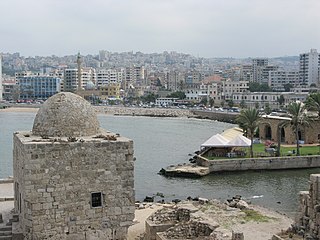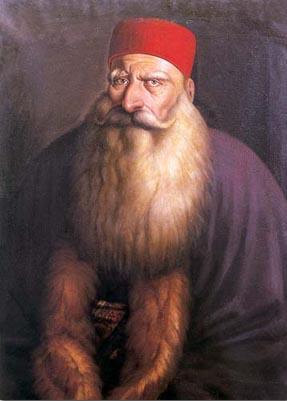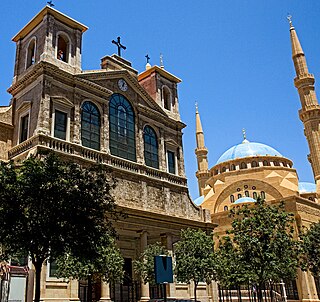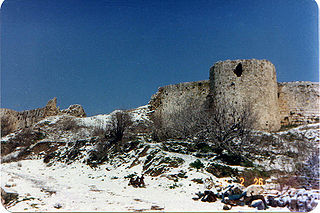Related Research Articles

Sidon or Saida is the third-largest city in Lebanon. It is located on the Mediterranean coast in the South Governorate, of which it is the capital. Tyre, to the south, and the Lebanese capital of Beirut, to the north, are both about 40 kilometres away. Sidon has a population of about 80,000 within the city limits, while its metropolitan area has more than a quarter-million inhabitants.

Fakhr al-Din Ma'n, commonly known as Fakhr al-Din II or Fakhreddine II, was the paramount Druze emir of Mount Lebanon from the Ma'n dynasty, an Ottoman governor of Sidon-Beirut and Safed, and the strongman over much of the Levant from the 1620s to 1633. For uniting modern Lebanon's constituent parts and communities, especially the Druze and the Maronites, under a single authority for the first time in history, he is generally regarded as the country's founder. Although he ruled in the name of the Ottomans, he acted with considerable autonomy and developed close ties with European powers in defiance of the Ottoman imperial government.

The sarcophagus ofEshmunazar II is a 6th-century BC sarcophagus unearthed in 1855 in the grounds of an ancient necropolis southeast of the city of Sidon, in modern-day Lebanon, that contained the body of Eshmunazar II, Phoenician King of Sidon. One of only three Ancient Egyptian sarcophagi found outside Egypt, with the other two belonging to Eshmunazar's father King Tabnit and to a woman, possibly Eshmunazar's mother Queen Amoashtart, it was likely carved in Egypt from local amphibolite, and captured as booty by the Sidonians during their participation in Cambyses II's conquest of Egypt in 525 BC. The sarcophagus has two sets of Phoenician inscriptions, one on its lid and a partial copy of it on the sarcophagus trough, around the curvature of the head. The lid inscription was of great significance upon its discovery as it was the first Phoenician language inscription to be discovered in Phoenicia proper and the most detailed Phoenician text ever found anywhere up to that point, and is today the second longest extant Phoenician inscription, after the Karatepe bilingual.

Bashir Shihab II was a Lebanese emir who ruled the Emirate of Mount Lebanon in the first half of the 19th century. Born to a branch of the Shihab family which had converted from Sunni Islam, the religion of previous Shihabi emirs, he was the only Maronite ruler of the Mount Lebanon Emirate.

Adel Osseiran, also transliterated Adil 'Usayran or Adil Osseyran, was a prominent Lebanese statesman, a former Speaker of the Lebanese Parliament, and one of the founding fathers of the Lebanese Republic.

The tourism industry in Lebanon has been important to the local economy historically and comprises a major source of revenue for the country.

Jbaa, is a municipality in Lebanon located about 22 km from Sidon and 64 km from Beirut. It is part of the Nabatieh Governorate. Jbaa is situated on the great Safi Mountain, and rises over 770 metres (2,530 ft) from the sea level and then begins to rise to 900 metres (3,000 ft) in the district of "Ein-Elsataoun". The village covers over 3,000 acres (12 km2). Surrounding the village is gorgeous greenery including diverse trees, especially walnut trees that spread around most of the town houses.

The Shihab dynasty is an Arab family whose members served as the paramount tax farmers and emirs of Mount Lebanon from the early 18th to mid-19th century, during Ottoman rule (1517–1918). Before then, the family had been in control of the Wadi al-Taym region, purportedly as early as the 12th century. During early Ottoman rule, they maintained an alliance and marital ties with the Ma'n dynasty, the Chouf-based, paramount Druze emirs and tax farmers of Mount Lebanon. When the last Ma'nid emir died without male progeny in 1697, the chiefs of the Druze in Mount Lebanon appointed the Shihab emir, Bashir, whose mother belonged to the Ma'n, as his successor. Bashir was succeeded by another Shihab emir with a Ma'nid mother, Haydar, after his death.

The 1860 civil conflict in Mount Lebanon and Damascus, also known as the 1860 Christian–Druze war, was a civil conflict in Mount Lebanon during Ottoman rule in 1860–1861 fought mainly between the local Druze and Christians.

The Ottoman Empire nominally ruled Mount Lebanon from its conquest in 1516 until the end of World War I in 1918.
Abela is a surname.

The Temple of Eshmun is an ancient place of worship dedicated to Eshmun, the Phoenician god of healing. It is located near the Awali river, 2 kilometres (1.2 mi) northeast of Sidon in southwestern Lebanon. The site was occupied from the 7th century BC to the 8th century AD, suggesting an integrated relationship with the nearby city of Sidon. Although originally constructed by Sidonian king Eshmunazar II in the Achaemenid era to celebrate the city's recovered wealth and stature, the temple complex was greatly expanded by Bodashtart, Yatonmilk and later monarchs. Because the continued expansion spanned many centuries of alternating independence and foreign hegemony, the sanctuary features a wealth of different architectural and decorative styles and influences.

The royal necropolis ofAyaa was a group of two hypogea housing a total of 21 sarcophagi of kings and nobles of the city of Sidon, a coastal city in Lebanon, and a prominent Phoenician city-state. The sarcophagi were highly diverse in style, ranging across Egyptian, Greek, Lycian and Phoenician styles. The Phoenicians exhibited diverse mortuary practices that included inhumation and cremation. While written records about their beliefs in the afterlife are scarce, archaeological evidence suggests they believed in an afterlife known as the "House of Eternity." Burial sites in Iron Age Phoenicia, like the Ayaa necropolis, were typically located outside settlements, and featured various tomb types and burial practices.

Eshmunazar II was the Phoenician king of Sidon. He was the grandson of Eshmunazar I, and a vassal king of the Persian Achaemenid Empire. Eshmunazar II succeeded his father Tabnit I who ruled for a short time and died before the birth of his son. Tabnit I was succeeded by his sister-wife Amoashtart who ruled alone until Eshmunazar II's birth, and then acted as his regent until the time he would have reached majority. Eshmunazar II died prematurely at the age of 14. He was succeeded by his cousin Bodashtart.

Pierre Bostani or Boutros Boustani was a Maronite prelate, Assistant to the Pontifical Throne, Archbishop of Tyre and Sidon, Count of Rome, Bishop of Saint-John-Acre, and Council Father of the First Vatican Council.

El-Assaad or Al As'ad is an Arab feudal political family who originated from Najd and is a main branch of the Anizah tribe. Unrelated to Syrian or Palestinian al-Assads, the El-Assaad dynasty that ruled most of South Lebanon for three centuries and whose lineage defended the local people of the Jabal Amel principality – today southern Lebanon – for 36 generations, they also held influence in Balqa in Jordan, Nablus in Palestine, and Homs in Syria during Ottomans rule.

The Saadé family is a prominent Greek Orthodox family from the Syrian coastal city of Latakia. They notably own two vineyards, Domaine de Bargylus in Syria and Château Marsyas in Lebanon, and have kept their production ongoing despite the chronic instability facing the Middle East.
The Kisrawan or Keserwan is a region between Mount Lebanon and the Mediterranean coast, north of the Lebanese capital Beirut and south of the Ibrahim River. It is administered by the eponymous Keserwan District, part of the Keserwan-Jbeil Governorate.
The Durighello family were a family of merchants in 19th century Sidon notable for their contributions to archaeology.
References
- ↑ Chancellerie du Consulat général de France à Beyrouth (24 April 1855). Litige entre Habib Abela el Alphonse Durighello à propos du sarcophage d'Eshmunazor II (PDF) (Report). Archived (PDF) from the original on 24 October 2020.
- ↑ Levi, L. (1861). Annals of British Legislation. Smith, Elder. p. 349-363. Retrieved 2023-06-17.
- ↑ Accounts and Papers of the House of Commons. Ordered to be printed. 1877. p. 5-PA34. Retrieved 2023-06-17.
- ↑ Yoshihiro Kimura (木村 喜博) (1987). A Study on the Formation of National Identity in the Arab East (東アラブ国家形成の研究). 研究双書. アジア経済研究所 (Institute of Developing Economies). p. 93. ISBN 978-4-258-04354-5.
- ↑ Fawaz, Leila Tarazi (1983). Merchants and Migrants in Nineteenth-century Beirut. Harvard Middle Eastern studies. Harvard University Press. pp. 89–90. ISBN 978-0-674-56925-6 . Retrieved 2023-06-17.
- ↑ Klat, Michel G. (2002). "The Durighello Family" (PDF). Archaeology & History in Lebanon (16). London: Lebanese British Friends of the National Museum: 103. Archived (PDF) from the original on 2021-02-11.
Alphonse Durighello and his wife Celeste had twelve children of which only seven - four girls and three boys - survived to adulthood. Of the girls Eulalie - born in Aleppo in 1845 - married in 1864 Job Abela (brother of Habib mentioned earlier)... According to Dr. Shaker Khoury, writing about the families of Damour, the wedding of Shaker Haykal to Eugenie Durighello and his brother Boutros to Angelique Abela, (daughter of the British Consul in Saida), which was celebrated on the same day, was hailed as the best the country had ever seen.
- ↑ F.O. 195/1153, George Jackson Eldridge to Austen Henry Layard, No. 48, 10-5-1877; quoted in Fawaz, 1983, p.90